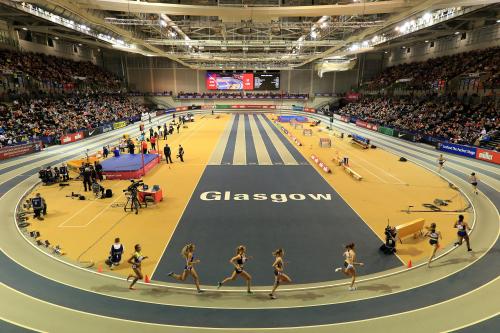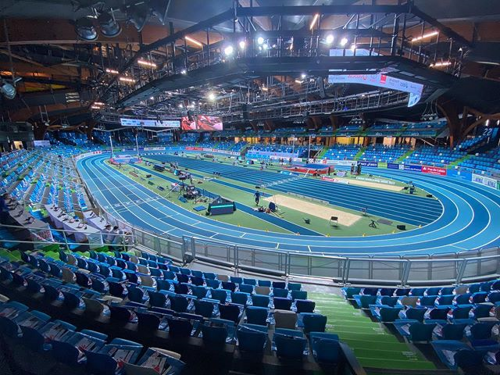 Andrew Pozzi, photo by British Athletics
Andrew Pozzi, photo by British Athletics
 Eilidh Doyle, photo by British Athletics
Eilidh Doyle, photo by British Athletics
RelatedPosts
 Emirates Arena, photo by British Athletics
Emirates Arena, photo by British Athletics
This piece came in today, from our British friend, Stuart Weir. Stuart has to stay close to home for a while, with life in the age of the coronavirus…
Indoor reflection
It is an interesting feature of our sport that there is an indoor version and an outdoor version. This year having attended three indoor events back to back, I found myself reflecting on the nature of indoor athletics. In 2014 I saw Shelly-Ann run her first indoor race. Had she really never run indoors before: “I’m from Jamaica, why would I want to run indoors?”, she replied!
In some disciplines, it makes little difference whether you are competing indoors or outdoors – perhaps the jumps. In some disciplines like javelin there is no indoor version. Races on a 6 late, banked 200m lap track are quite different from the same distance run on a 400m, 8 lane, flat track. There are more tangled legs, falls and disqualifications indoors. Who can forget the race at the Birmingham World Indoors where all the athletes were DQed! I understand that the reason that the 200m has been dropped as a championship distance is that it not felt that it is a fair race between inside and outside lanes around the tight bends.
Athletes do indoors with different motivations. Some want to win indoor championship medals. Two athletes, in the form of their lives this indoor season, told me they were really disappointed not to have the chance to complete in an indoor worlds this year. Others just want to test their fitness after winter training or break up a boring block of training with a race. Not many athletes though, would disagree with what Charlie Da’vall Grice said to me in Lievin: “By the time the Olympics comes, no one will remember what I did indoors”.
In some disciplines the standard distance is shorter eg 60m instead of 100/110. Lawrence Clarke (4th in the London Olympics high hurdles) told me he saw the indoor as getting the first 60 meters of the race right so that when he transferred outside, he only had to work on the final 50 meters. On the other hand, Andy Pozzi (World and European indoor 60mH champion) understood exactly why he was more successful over the shorter indoor distance, that he struggled to hurdle cleanly when running faster over the last few hurdles.
The most exciting race I have ever seen was the women’s 4 by 400m relay in Istanbul 2012. Eilidh Doyle, serial relay medalist for GB once explained relays to me. “Indoors it’s very tactical and very dependent on lane draw. You really want one of the outside lanes for the first leg because you really want to be in amongst it. It’s a lot more tactical than the outdoor 4 by 400. Outdoors I think whoever has the fastest athletes will win. Indoors you can win without having the fastest athletes just by getting your athletes in the order right and getting your tactics right”. Getting the tactics right often means getting in front knowing that overtaking, even for a faster athlete, on the short straights and tight bends is not easy.
I once asked Hellen Obiri – Kenyan and with no indoor tracks at home – how come she was so successful in indoor running. She said once you got used to running twice as many indoor laps as outdoor, there was no real difference. It was just a race.
A lot of it comes down to individual preference. It was interesting to hear Mondo, Sam and Sandi say recently how the noise and atmosphere helped them vault better. They talked of taking energy from the crowd. Levern Spencer, on the other hand, told me she high-jumps better outdoors because “I like space and I like the air. There are a lot less distractions indoors. And indoors a lot of the surfaces are different. Some of them are regular track, some of them are laid down track. Sometimes we jump with pole vaulters, sometimes we run across the 60 meter track. Sometimes you have to stop or when someone is running across you. With the spectators right next to you and with so much going on. it is hard to stay focused. I think it’s because there is so much going on indoors that I do better outdoors”. Again, I have heard long jumpers and vaulters say they prefer indoors because you don’t have to worry about the wind.
 Lieven, France, photo by British Athletics
Lieven, France, photo by British Athletics
In Lievin this year there was an indoor 2000m steeplechase – sadly without water. It was fascinating to see runners negotiate the barriers on the tight circuit. It worked well. A few years ago Birmingham tried an indoor 400m hurdles. It was chaotic, with running on the banked bends finding their stride pattern messed-up. Hilarious to watch but not a serious race.
As a spectator event, indoor athletics is brilliant. With a packed program in a sell-out venue, the atmosphere is incredible. But a good outdoor meet with the sun shining is hard to beat. Track and field is lucky to have two different but complementary versions of the sport.
Author

Since 2015, Stuart Weir has written for RunBlogRun. He attends about 20 events a year including all most global championships and Diamond Leagues. He enjoys finding the quirky and obscure story.
View all posts




















